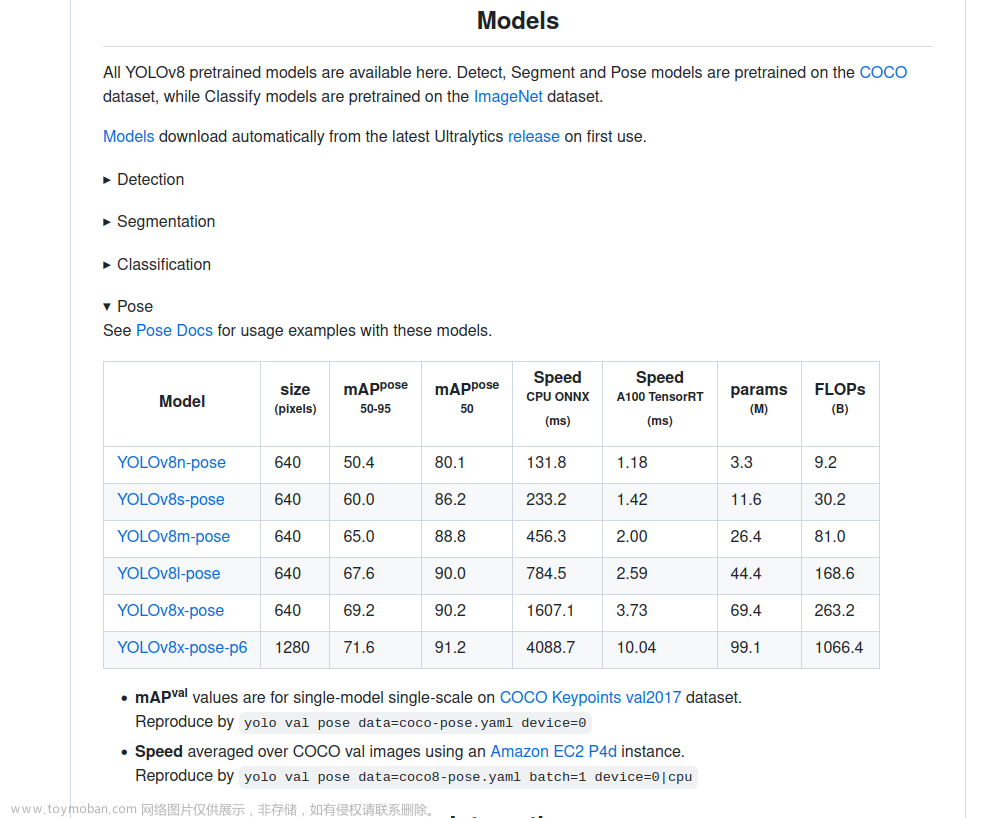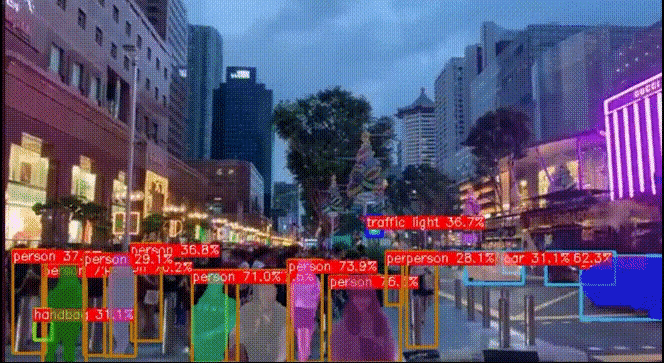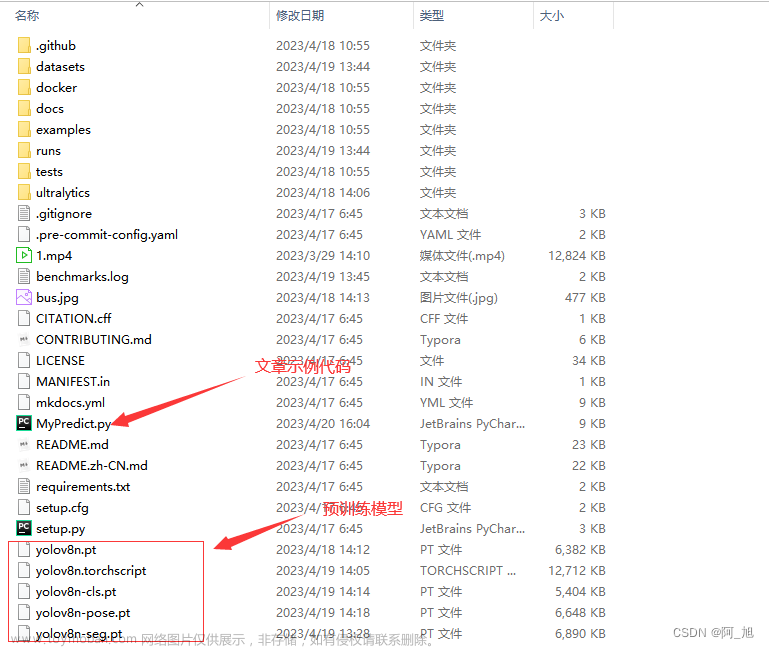openvino部署yolov8 检测、分割、分类及姿态模型实例详解
- 本文重点参考:https://github.com/openvino-book/yolov8_openvino_cpp/tree/main
- 文中代码为简便版本,如果要使用请自行修改并封装
- openvnio部署模型比较方便和简单,而且不易出错,就是速度慢了点!
- 下边分别给出 部署源码
1. 检测模型
#include <iostream>
#include <string>
#include <vector>
#include <openvino/openvino.hpp> //openvino header file
#include <opencv2/opencv.hpp> //opencv header file
std::vector<cv::Scalar> colors = { cv::Scalar(0, 0, 255) , cv::Scalar(0, 255, 0) , cv::Scalar(255, 0, 0) ,
cv::Scalar(255, 100, 50) , cv::Scalar(50, 100, 255) , cv::Scalar(255, 50, 100) };
const std::vector<std::string> class_names = {
"person", "bicycle", "car", "motorcycle", "airplane", "bus", "train", "truck", "boat", "traffic light",
"fire hydrant", "stop sign", "parking meter", "bench", "bird", "cat", "dog", "horse", "sheep", "cow",
"elephant", "bear", "zebra", "giraffe", "backpack", "umbrella", "handbag", "tie", "suitcase", "frisbee",
"skis", "snowboard", "sports ball", "kite", "baseball bat", "baseball glove", "skateboard", "surfboard",
"tennis racket", "bottle", "wine glass", "cup", "fork", "knife", "spoon", "bowl", "banana", "apple",
"sandwich", "orange", "broccoli", "carrot", "hot dog", "pizza", "donut", "cake", "chair", "couch",
"potted plant", "bed", "dining table", "toilet", "tv", "laptop", "mouse", "remote", "keyboard", "cell phone",
"microwave", "oven", "toaster", "sink", "refrigerator", "book", "clock", "vase", "scissors", "teddy bear",
"hair drier", "toothbrush" };
using namespace cv;
using namespace dnn;
// Keep the ratio before resize
Mat letterbox(const cv::Mat& source)
{
int col = source.cols;
int row = source.rows;
int _max = MAX(col, row);
Mat result = Mat::zeros(_max, _max, CV_8UC3);
source.copyTo(result(Rect(0, 0, col, row)));
return result;
}
int main(int argc, char* argv[])
{
// -------- Step 1. Initialize OpenVINO Runtime Core --------
ov::Core core;
// -------- Step 2. Compile the Model --------
auto compiled_model = core.compile_model("yolov8n.xml", "CPU");
// -------- Step 3. Create an Inference Request --------
ov::InferRequest infer_request = compiled_model.create_infer_request();
// -------- Step 4.Read a picture file and do the preprocess --------
Mat img = cv::imread("bus.jpg");
// Preprocess the image
Mat letterbox_img = letterbox(img);
float scale = letterbox_img.size[0] / 640.0;
Mat blob = blobFromImage(letterbox_img, 1.0 / 255.0, Size(640, 640), Scalar(), true);
// -------- Step 5. Feed the blob into the input node of the Model -------
// Get input port for model with one input
auto input_port = compiled_model.input();
// Create tensor from external memory
ov::Tensor input_tensor(input_port.get_element_type(), input_port.get_shape(), blob.ptr(0));
// Set input tensor for model with one input
infer_request.set_input_tensor(input_tensor);
// -------- Step 6. Start inference --------
infer_request.infer();
// -------- Step 7. Get the inference result --------
auto output = infer_request.get_output_tensor(0);
auto output_shape = output.get_shape();
std::cout << "The shape of output tensor:" << output_shape << std::endl;
int rows = output_shape[2]; //8400
int dimensions = output_shape[1]; //84: box[cx, cy, w, h]+80 classes scores
// -------- Step 8. Postprocess the result --------
float* data = output.data<float>();
Mat output_buffer(output_shape[1], output_shape[2], CV_32F, data);
transpose(output_buffer, output_buffer); //[8400,84]
float score_threshold = 0.25;
float nms_threshold = 0.5;
std::vector<int> class_ids;
std::vector<float> class_scores;
std::vector<Rect> boxes;
// Figure out the bbox, class_id and class_score
for (int i = 0; i < output_buffer.rows; i++) {
Mat classes_scores = output_buffer.row(i).colRange(4, 84);
Point class_id;
double maxClassScore;
minMaxLoc(classes_scores, 0, &maxClassScore, 0, &class_id);
if (maxClassScore > score_threshold) {
class_scores.push_back(maxClassScore);
class_ids.push_back(class_id.x);
float cx = output_buffer.at<float>(i, 0);
float cy = output_buffer.at<float>(i, 1);
float w = output_buffer.at<float>(i, 2);
float h = output_buffer.at<float>(i, 3);
int left = int((cx - 0.5 * w) * scale);
int top = int((cy - 0.5 * h) * scale);
int width = int(w * scale);
int height = int(h * scale);
boxes.push_back(Rect(left, top, width, height));
}
}
//NMS
std::vector<int> indices;
NMSBoxes(boxes, class_scores, score_threshold, nms_threshold, indices);
// -------- Visualize the detection results -----------
for (size_t i = 0; i < indices.size(); i++) {
int index = indices[i];
int class_id = class_ids[index];
rectangle(img, boxes[index], colors[class_id % 6], 2, 8);
std::string label = class_names[class_id] + ":" + std::to_string(class_scores[index]).substr(0, 4);
Size textSize = cv::getTextSize(label, FONT_HERSHEY_SIMPLEX, 0.5, 1, 0);
Rect textBox(boxes[index].tl().x, boxes[index].tl().y - 15, textSize.width, textSize.height+5);
cv::rectangle(img, textBox, colors[class_id % 6], FILLED);
putText(img, label, Point(boxes[index].tl().x, boxes[index].tl().y - 5), FONT_HERSHEY_SIMPLEX, 0.5, Scalar(255, 255, 255));
}
namedWindow("YOLOv8 OpenVINO Inference C++ Demo", WINDOW_AUTOSIZE);
imshow("YOLOv8 OpenVINO Inference C++ Demo", img);
waitKey(0);
destroyAllWindows();
return 0;
}
2. 分割模型
#include <iostream>
#include <string>
#include <vector>
#include <algorithm>
#include <openvino/openvino.hpp> //openvino header file
#include <opencv2/opencv.hpp> //opencv header file
using namespace cv;
using namespace dnn;
std::vector<Scalar> colors = { Scalar(255, 0, 0), Scalar(255, 0, 255), Scalar(170, 0, 255), Scalar(255, 0, 85),
Scalar(255, 0, 170), Scalar(85, 255, 0), Scalar(255, 170, 0), Scalar(0, 255, 0),
Scalar(255, 255, 0), Scalar(0, 255, 85), Scalar(170, 255, 0), Scalar(0, 85, 255),
Scalar(0, 255, 170), Scalar(0, 0, 255), Scalar(0, 255, 255), Scalar(85, 0, 255)};
const std::vector<std::string> class_names = {
"person", "bicycle", "car", "motorcycle", "airplane", "bus", "train", "truck", "boat", "traffic light",
"fire hydrant", "stop sign", "parking meter", "bench", "bird", "cat", "dog", "horse", "sheep", "cow",
"elephant", "bear", "zebra", "giraffe", "backpack", "umbrella", "handbag", "tie", "suitcase", "frisbee",
"skis", "snowboard", "sports ball", "kite", "baseball bat", "baseball glove", "skateboard", "surfboard",
"tennis racket", "bottle", "wine glass", "cup", "fork", "knife", "spoon", "bowl", "banana", "apple",
"sandwich", "orange", "broccoli", "carrot", "hot dog", "pizza", "donut", "cake", "chair", "couch",
"potted plant", "bed", "dining table", "toilet", "tv", "laptop", "mouse", "remote", "keyboard", "cell phone",
"microwave", "oven", "toaster", "sink", "refrigerator", "book", "clock", "vase", "scissors", "teddy bear",
"hair drier", "toothbrush" };
// Keep the ratio before resize
Mat letterbox(const cv::Mat& source)
{
int col = source.cols;
int row = source.rows;
int _max = MAX(col, row);
Mat result = Mat::zeros(_max, _max, CV_8UC3);
source.copyTo(result(Rect(0, 0, col, row)));
return result;
}
float sigmoid_function(float a){
float b = 1. / (1. + exp(-a));
return b;
}
int main(int argc, char* argv[])
{
// -------- Step 1. Initialize OpenVINO Runtime Core --------
ov::Core core;
// -------- Step 2. Compile the Model --------
auto compiled_model = core.compile_model("yolov8n-seg.xml", "CPU");
// -------- Step 3. Create an Inference Request --------
ov::InferRequest infer_request = compiled_model.create_infer_request();
// -------- Step 4.Read a picture file and do the preprocess --------
Mat img = cv::imread("bus.jpg");
// Preprocess the image
Mat letterbox_img = letterbox(img);
float scale = letterbox_img.size[0] / 640.0;
Mat blob = blobFromImage(letterbox_img, 1.0 / 255.0, Size(640, 640), Scalar(), true);
// -------- Step 5. Feed the blob into the input node of the Model -------
// Get input port for model with one input
auto input_port = compiled_model.input();
// Create tensor from external memory
ov::Tensor input_tensor(input_port.get_element_type(), input_port.get_shape(), blob.ptr(0));
// Set input tensor for model with one input
infer_request.set_input_tensor(input_tensor);
// -------- Step 6. Start inference --------
infer_request.infer();
// -------- Step 7. Get the inference result --------
auto output0 = infer_request.get_output_tensor(0); //output0
auto output1 = infer_request.get_output_tensor(1); //otuput1
auto output0_shape = output0.get_shape();
auto output1_shape = output1.get_shape();
std::cout << "The shape of output0:" << output0_shape << std::endl;
std::cout << "The shape of output1:" << output1_shape << std::endl;
// -------- Step 8. Postprocess the result --------
Mat output_buffer(output0_shape[1], output0_shape[2], CV_32F, output0.data<float>());
Mat proto(32, 25600, CV_32F, output1.data<float>()); //[32,25600]
transpose(output_buffer, output_buffer); //[8400,116]
float score_threshold = 0.25;
float nms_threshold = 0.5;
std::vector<int> class_ids;
std::vector<float> class_scores;
std::vector<Rect> boxes;
std::vector<Mat> mask_confs;
// Figure out the bbox, class_id and class_score
for (int i = 0; i < output_buffer.rows; i++) {
Mat classes_scores = output_buffer.row(i).colRange(4, 84);
Point class_id;
double maxClassScore;
minMaxLoc(classes_scores, 0, &maxClassScore, 0, &class_id);
if (maxClassScore > score_threshold) {
class_scores.push_back(maxClassScore);
class_ids.push_back(class_id.x);
float cx = output_buffer.at<float>(i, 0);
float cy = output_buffer.at<float>(i, 1);
float w = output_buffer.at<float>(i, 2);
float h = output_buffer.at<float>(i, 3);
int left = int((cx - 0.5 * w) * scale);
int top = int((cy - 0.5 * h) * scale);
int width = int(w * scale);
int height = int(h * scale);
cv::Mat mask_conf = output_buffer.row(i).colRange(84, 116);
mask_confs.push_back(mask_conf);
boxes.push_back(Rect(left, top, width, height));
}
}
//NMS
std::vector<int> indices;
NMSBoxes(boxes, class_scores, score_threshold, nms_threshold, indices);
// -------- Visualize the detection results -----------
cv::Mat rgb_mask = cv::Mat::zeros(img.size(), img.type());
cv::Mat masked_img;
cv::RNG rng;
for (size_t i = 0; i < indices.size(); i++) {
// Visualize the objects
int index = indices[i];
int class_id = class_ids[index];
rectangle(img, boxes[index], colors[class_id % 16], 2, 8);
std::string label = class_names[class_id] + ":" + std::to_string(class_scores[index]).substr(0, 4);
Size textSize = cv::getTextSize(label, FONT_HERSHEY_SIMPLEX, 0.5, 1, 0);
Rect textBox(boxes[index].tl().x, boxes[index].tl().y - 15, textSize.width, textSize.height+5);
cv::rectangle(img, textBox, colors[class_id % 16], FILLED);
putText(img, label, Point(boxes[index].tl().x, boxes[index].tl().y - 5), FONT_HERSHEY_SIMPLEX, 0.5, Scalar(255, 255, 255));
// Visualize the Masks
Mat m = mask_confs[i] * proto;
for (int col = 0; col < m.cols; col++) {
m.at<float>(0, col) = sigmoid_function(m.at<float>(0, col));
}
cv::Mat m1 = m.reshape(1, 160); // 1x25600 -> 160x160
int x1 = std::max(0, boxes[index].x);
int y1 = std::max(0, boxes[index].y);
int x2 = std::max(0, boxes[index].br().x);
int y2 = std::max(0, boxes[index].br().y);
int mx1 = int(x1 / scale * 0.25);
int my1 = int(y1 / scale * 0.25);
int mx2 = int(x2 / scale * 0.25);
int my2 = int(y2 / scale * 0.25);
cv::Mat mask_roi = m1(cv::Range(my1, my2), cv::Range(mx1, mx2));
cv::Mat rm, det_mask;
cv::resize(mask_roi, rm, cv::Size(x2 - x1, y2 - y1));
for (int r = 0; r < rm.rows; r++) {
for (int c = 0; c < rm.cols; c++) {
float pv = rm.at<float>(r, c);
if (pv > 0.5) {
rm.at<float>(r, c) = 1.0;
}
else {
rm.at<float>(r, c) = 0.0;
}
}
}
rm = rm * rng.uniform(0, 255);
rm.convertTo(det_mask, CV_8UC1);
if ((y1 + det_mask.rows) >= img.rows) {
y2 = img.rows - 1;
}
if ((x1 + det_mask.cols) >= img.cols) {
x2 = img.cols - 1;
}
cv::Mat mask = cv::Mat::zeros(cv::Size(img.cols, img.rows), CV_8UC1);
det_mask(cv::Range(0, y2 - y1), cv::Range(0, x2 - x1)).copyTo(mask(cv::Range(y1, y2), cv::Range(x1, x2)));
add(rgb_mask, cv::Scalar(rng.uniform(0, 255), rng.uniform(0, 255), rng.uniform(0, 255)), rgb_mask, mask);
addWeighted(img, 0.5, rgb_mask, 0.5, 0, masked_img);
}
namedWindow("YOLOv8-Seg OpenVINO Inference C++ Demo", WINDOW_AUTOSIZE);
imshow("YOLOv8-Seg OpenVINO Inference C++ Demo", masked_img);
waitKey(0);
destroyAllWindows();
return 0;
}
3. 分类模型
#include <iostream>
#include <string>
#include <vector>
#include <algorithm>
#include <openvino/openvino.hpp> //openvino header file
#include <opencv2/opencv.hpp> //opencv header file
using namespace cv;
using namespace dnn;
// Keep the ratio before resize
Mat letterbox(const cv::Mat& source)
{
int col = source.cols;
int row = source.rows;
int _max = MAX(col, row);
Mat result = Mat::zeros(_max, _max, CV_8UC3);
source.copyTo(result(Rect(0, 0, col, row)));
return result;
}
int main(int argc, char* argv[])
{
// -------- Step 1. Initialize OpenVINO Runtime Core --------
ov::Core core;
// -------- Step 2. Compile the Model --------
auto compiled_model = core.compile_model("yolov8n-cls.xml", "CPU");
// -------- Step 3. Create an Inference Request --------
ov::InferRequest infer_request = compiled_model.create_infer_request();
// -------- Step 4.Read a picture file and do the preprocess --------
Mat img = cv::imread("bus.jpg");
// Preprocess the image
Mat letterbox_img = letterbox(img);
Mat blob = blobFromImage(letterbox_img, 1.0 / 255.0, Size(224, 224), Scalar(), true);
// -------- Step 5. Feed the blob into the input node of the Model -------
// Get input port for model with one input
auto input_port = compiled_model.input();
// Create tensor from external memory
ov::Tensor input_tensor(input_port.get_element_type(), input_port.get_shape(), blob.ptr(0));
// Set input tensor for model with one input
infer_request.set_input_tensor(input_tensor);
// -------- Step 6. Start inference --------
infer_request.infer();
// -------- Step 7. Get the inference result --------
auto output = infer_request.get_output_tensor(0);
auto output_shape = output.get_shape();
std::cout << "The shape of output tensor:" << output_shape << std::endl;
// -------- Step 8. Postprocess the result --------
float* output_buffer = output.data<float>();
std::vector<float> result(output_buffer, output_buffer + output_shape[1]);
auto max_idx = std::max_element(result.begin(), result.end());
int class_id = max_idx - result.begin();
float score = *max_idx;
std::cout << "Class ID:" << class_id << " Score:" <<score<< std::endl;
return 0;
}
4. 姿态模型
#include <iostream>
#include <string>
#include <vector>
#include <algorithm>
#include <openvino/openvino.hpp> //openvino header file
#include <opencv2/opencv.hpp> //opencv header file
using namespace cv;
using namespace dnn;
//Colors for 17 keypoints
std::vector<cv::Scalar> colors = { Scalar(255, 0, 0), Scalar(255, 0, 255), Scalar(170, 0, 255), Scalar(255, 0, 85),
Scalar(255, 0, 170), Scalar(85, 255, 0), Scalar(255, 170, 0), Scalar(0, 255, 0),
Scalar(255, 255, 0), Scalar(0, 255, 85), Scalar(170, 255, 0), Scalar(0, 85, 255),
Scalar(0, 255, 170), Scalar(0, 0, 255), Scalar(0, 255, 255), Scalar(85, 0, 255),
Scalar(0, 170, 255)};
// Keep the ratio before resize
Mat letterbox(const cv::Mat& source)
{
int col = source.cols;
int row = source.rows;
int _max = MAX(col, row);
Mat result = Mat::zeros(_max, _max, CV_8UC3);
source.copyTo(result(Rect(0, 0, col, row)));
return result;
}
int main(int argc, char* argv[])
{
// -------- Step 1. Initialize OpenVINO Runtime Core --------
ov::Core core;
// -------- Step 2. Compile the Model --------
auto compiled_model = core.compile_model("yolov8n-pose.xml", "CPU");
// -------- Step 3. Create an Inference Request --------
ov::InferRequest infer_request = compiled_model.create_infer_request();
// -------- Step 4.Read a picture file and do the preprocess --------
Mat img = cv::imread("bus.jpg");
// Preprocess the image
Mat letterbox_img = letterbox(img);
float scale = letterbox_img.size[0] / 640.0;
Mat blob = blobFromImage(letterbox_img, 1.0 / 255.0, Size(640, 640), Scalar(), true);
// -------- Step 5. Feed the blob into the input node of the Model -------
// Get input port for model with one input
auto input_port = compiled_model.input();
// Create tensor from external memory
ov::Tensor input_tensor(input_port.get_element_type(), input_port.get_shape(), blob.ptr(0));
// Set input tensor for model with one input
infer_request.set_input_tensor(input_tensor);
// -------- Step 6. Start inference --------
infer_request.infer();
// -------- Step 7. Get the inference result --------
auto output = infer_request.get_output_tensor(0);
auto output_shape = output.get_shape();
std::cout << "The shape of output tensor:" << output_shape << std::endl;
// -------- Step 8. Postprocess the result --------
float* data = output.data<float>();
Mat output_buffer(output_shape[1], output_shape[2], CV_32F, data);
transpose(output_buffer, output_buffer); //[8400,56]
float score_threshold = 0.25;
float nms_threshold = 0.5;
std::vector<int> class_ids;
std::vector<float> class_scores;
std::vector<Rect> boxes;
std::vector<std::vector<float>> objects_keypoints;
// //56: box[cx, cy, w, h] + Score + [17,3] keypoints
for (int i = 0; i < output_buffer.rows; i++) {
float class_score = output_buffer.at<float>(i, 4);
if (class_score > score_threshold) {
class_scores.push_back(class_score);
class_ids.push_back(0); //{0:"person"}
float cx = output_buffer.at<float>(i, 0);
float cy = output_buffer.at<float>(i, 1);
float w = output_buffer.at<float>(i, 2);
float h = output_buffer.at<float>(i, 3);
// Get the box
int left = int((cx - 0.5 * w) * scale);
int top = int((cy - 0.5 * h) * scale);
int width = int(w * scale);
int height = int(h * scale);
// Get the keypoints
std::vector<float> keypoints;
Mat kpts = output_buffer.row(i).colRange(5, 56);
for (int i = 0; i < 17; i++) {
float x = kpts.at<float>(0, i * 3 + 0) * scale;
float y = kpts.at<float>(0, i * 3 + 1) * scale;
float s = kpts.at<float>(0, i * 3 + 2);
keypoints.push_back(x);
keypoints.push_back(y);
keypoints.push_back(s);
}
boxes.push_back(Rect(left, top, width, height));
objects_keypoints.push_back(keypoints);
}
}
//NMS
std::vector<int> indices;
NMSBoxes(boxes, class_scores, score_threshold, nms_threshold, indices);
// -------- Visualize the detection results -----------
for (size_t i = 0; i < indices.size(); i++) {
int index = indices[i];
// Draw bounding box
rectangle(img, boxes[index], Scalar(0, 0, 255), 2, 8);
std::string label = "Person:" + std::to_string(class_scores[index]).substr(0, 4);
Size textSize = cv::getTextSize(label, FONT_HERSHEY_SIMPLEX, 0.5, 1, 0);
Rect textBox(boxes[index].tl().x, boxes[index].tl().y - 15, textSize.width, textSize.height+5);
cv::rectangle(img, textBox, Scalar(0, 0, 255), FILLED);
putText(img, label, Point(boxes[index].tl().x, boxes[index].tl().y - 5), FONT_HERSHEY_SIMPLEX, 0.5, Scalar(255, 255, 255));
// Draw keypoints
std::vector<float> object_keypoints = objects_keypoints[index];
for (int i = 0; i < 17; i++) {
int x = std::clamp(int(object_keypoints[i*3+0]), 0, img.cols);
int y = std::clamp(int(object_keypoints[i*3+1]), 0, img.rows);
//Draw point
circle(img, Point(x, y), 5, colors[i], -1);
}
}
namedWindow("YOLOv8-Pose OpenVINO Inference C++ Demo", WINDOW_AUTOSIZE);
imshow("YOLOv8-Pose OpenVINO Inference C++ Demo", img);
waitKey(0);
destroyAllWindows();
return 0;
}
文章来源地址https://www.toymoban.com/news/detail-601321.html
文章来源:https://www.toymoban.com/news/detail-601321.html
到了这里,关于openvino部署yolov8 检测、分割、分类及姿态模型实例详解的文章就介绍完了。如果您还想了解更多内容,请在右上角搜索TOY模板网以前的文章或继续浏览下面的相关文章,希望大家以后多多支持TOY模板网!











